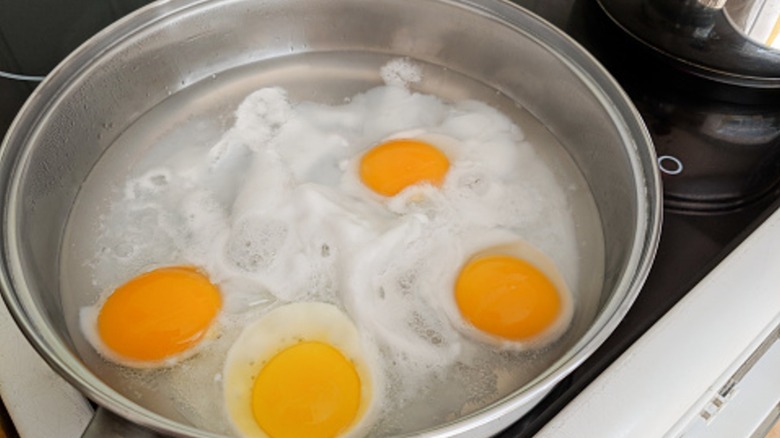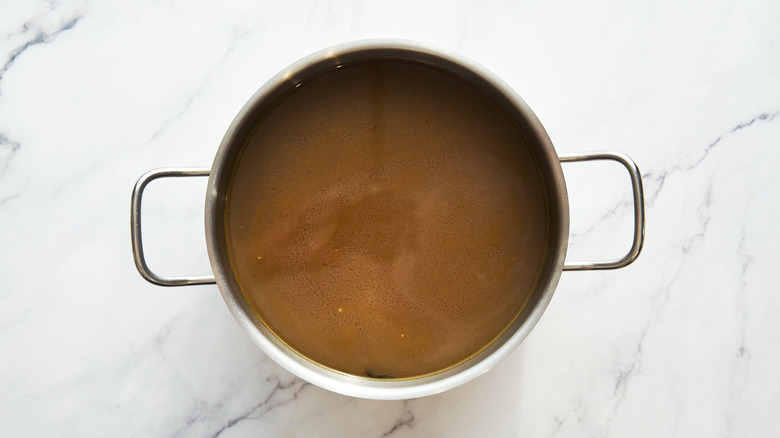The Simple Ingredient Swap For More Flavorful Poached Eggs
Eggs can be poached in plain water and come out perfect, but it's also possible to cook them in other liquids. If you're into super-sweet flavors, you could be poaching your eggs in maple syrup, or you could give eggs the pizza treatment by cooking them in tomato sauce for an Italian-ish twist on shakshuka. Of course, you could always make actual Moroccan shakshuka which basically demands that you "put an egg on it." But Nelson Serrano-Bahri, director of innovation at the American Egg Board, suggests something cheaper than syrup and subtler than tomato sauce: broth or stock (and, yes, you can substitute broth for stock in this scenario).
"Poaching eggs in a low-sodium, well-skimmed broth infuses subtle savory depth," says Serrano-Bahri. "The short cooking time means the yolk won't absorb much, but the whites pick up gentle meaty, vegetal, or umami notes." He also notes that the leftover broth needn't go to waste, but can be used as a sauce for serving. If you'd like something thicker than water, you can boil the poaching broth down to a concentrate or add a small amount of flour or cornstarch.
How to poach eggs in broth
The first step to poaching eggs in broth involves making sure that the liquid isn't too salty since, as Nelson Serrano-Bahri informs us, "Excess sodium toughens whites." If you're using homemade stock and you've salted it generously, add some water to lower the concentration. You'll also need to remove any surface fat, since this will make for a better appearance and what Serrano-Bahri calls a cleaner flavor.
Once you've got the stock sorted out, bring it to a simmer, but don't let it come to a boil. "Vigorous boiling tears the whites; gentle convection helps them wrap neatly," says Serrano-Bahri. If you want the egg whites to look neater and cook more quickly, you can pour in one to two teaspoons of vinegar per quart of water. When the water is simmering, crack each egg into a cup, dish, or ramekin and slide it into the water near the surface. Poach the eggs for three to four minutes, which should be long enough to firm up the whites while leaving the yolk soft.
If your broth is greasy or has a very strong flavor, you might want to dip the eggs in warm water to rinse them off before eating. Conversely, for intensified broth flavor, sprinkle some cooking liquid over the eggs if you'll be eating them as part of a noodle or rice bowl, or salad. If you prefer poached eggs with toast or English muffins, reduce and thicken the liquid to keep the bread from becoming soggy.
What types of broth can be used to poach eggs?
Just about any kind of stock or broth will do for egg poaching — even bouillon from a cube. You can further flavor the broth with a few well-chosen additions, too. Nelson Serrano-Bahri says mild, savory chicken broth goes well with herbs or green onions, and can also be enhanced with soy sauce. Fish sauce would work, too, and you could add some lime juice, mint, or cilantro for Asian-inspired eggs.
Serrano-Bahri also favors umami-rich mushroom broth, calling it "deeply earthy; excellent over miso butter toast or parmesan grits." And as far as beef broth, he says, "[It] adds gentle richness [and is] great for ramen-style bowls." If you're a fan of bone broth, this, too, can be used as an egg-poaching medium. According to Serrano-Bahri, "Its gelatin content gives body and shine to the whites, but skim fat and use low salt to avoid rubbery texture."


